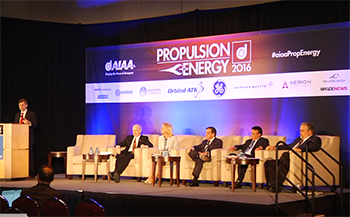Study Questions Near-Term Value of Battery Tech for Large Planes Written 25 July 2016
Panelists: Moderator Marty Bradley, technical fellow, Boeing; Alan Angleman, senior program officer and study director for the aviation carbon reduction committee, Aeronautics and Space Engineering Board, National Academies of Sciences, Engineering and Medicine; Mike Benzakein, director, Propulsion and Power Center, Ohio State University, and member of the aviation carbon reduction committee, National Academies; Steve Csonka, executive director, Commercial Aviation Alternative Fuels Initiative, and member of the aviation carbon reduction committee, National Academies; Alan Epstein, vice president for technology and environment, Pratt and Whitney, and member of the aviation carbon reduction committee, National Academies; Karen Thole, head of nuclear and mechanical engineering department, Pennsylvania State University, and co-chair of the aviation carbon reduction committee, National Academies
By Ben Iannotta, Aerospace America Editor-in-Chief

Turboelectric propulsion, in which fuel-burning engines generate electricity for propulsion, has a better chance of significantly reducing the carbon footprint of large commercial planes within 30 years than do batteries or hybrid engines.
That was a key conclusion of the Committee on Propulsion and Energy Systems to Reduce Commercial Aviation Carbon Emissions. The group was formed by the National Academies of Sciences, Engineering and Medicine to suggest research priorities for NASA as it seeks to reduce carbon emissions from aircraft.
Members of the committee have been briefing their findings to congressional staffs and agencies since releasing their report. On July 25, they discussed their recommendations with an audience at 2016 AIAA Propulsion and Energy Forum in Salt Lake City.
“Turboelectric propulsion, coupled with distributed propulsion and boundary layer ingestion, have the potential to reduce fuel burn and emissions by 20 percent or more compared to the current state of the art for large commercial aircraft,” said Mike Benzakein, a member of the committee and an aerospace engineering professor at Ohio State University.
Karen Thole, a committee co-chair and professor of nuclear and mechanical engineering at Penn State, cautioned that the committee didn’t say “stop working on batteries.” She said the study’s “boundary condition” of identifying technologies that could be ready no later than 30 years from now prompted the recommendation to focus on turboelectric propulsion, related technologies and alternative fuels.
Pratt and Whitney’s Alan Epstein, a member of the committee and the company’s vice president for technology and environment, said “no battery chemistries” exist right now with the potential to power large commercial aircraft.
Shifting to the state of the U.S. research infrastructure, Thole said “megawatt class” research facilities are critical but that there are no “facilities available for this megawatt class research.”
The committee looked at technologies for single- and double-aisle passenger jets capable of carrying 100 passengers or more. Those aircraft comprise 90 percent of the carbon emissions from the aviation segment, Thole said. She added that the segment burns 7 billion gallons of fuel.
“A systemic change needed to be considered at that kind of scaling,” she said.
The committee looked at engine technology, including nacelle designs and internal coatings that might let engine cores burn hotter. Epstein said ultimately, propulsion and aircraft designs will need to be considered together as a system, even if that was not the committee’s focus.
The committee also lauded the potential of sustainable alternative fuels to reduce aviation’s carbon footprint.
The “really good news” is that if society decides to take action, “these reductions can be immediate,” said Steven Csonka, a member of the committee and executive director of the Commercial Aviation Alternative Fuels Initiative.
Advances in alternative fuels are critical, he said, because “we expect to be using fuel in aircraft at least for the next five decades.”
Csonka cautioned that not all alternative fuels are created equal. He said some, such as those derived from coal, can have a “higher carbon footprint” because they do not involve sustainably cycling carbon through biomass.
